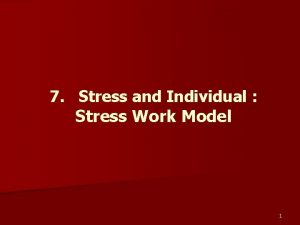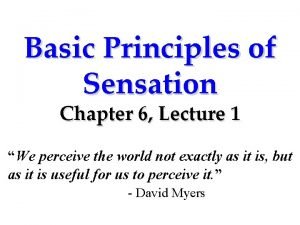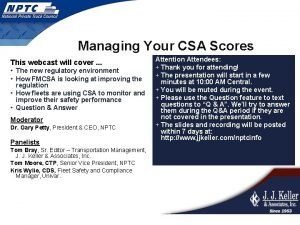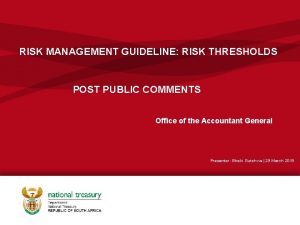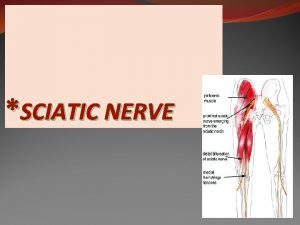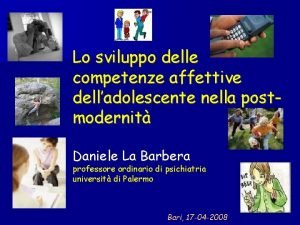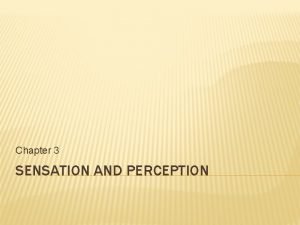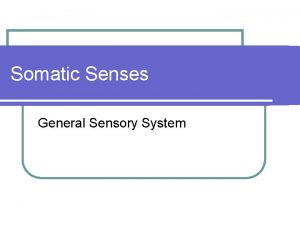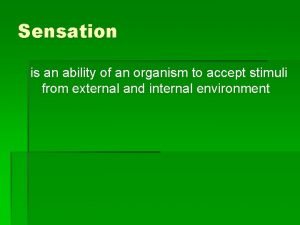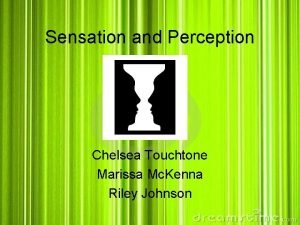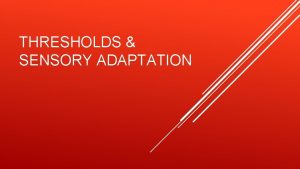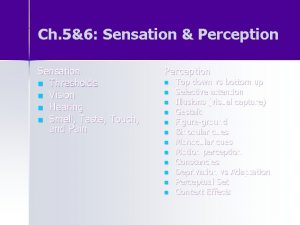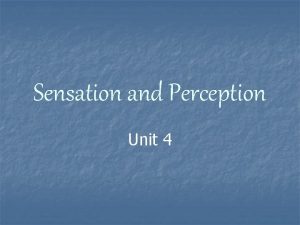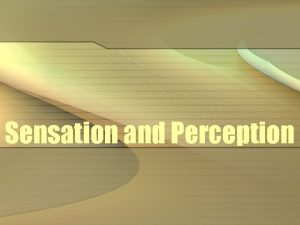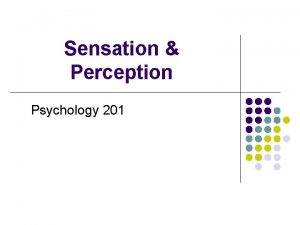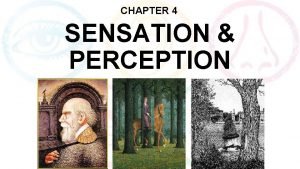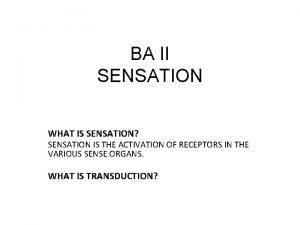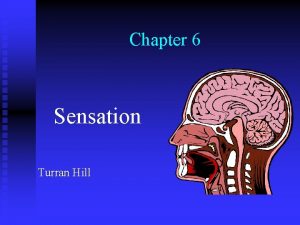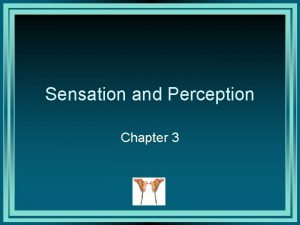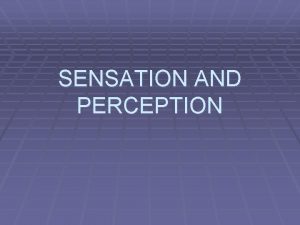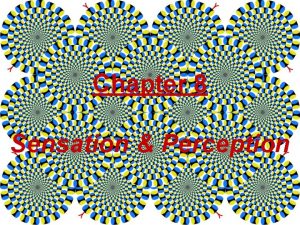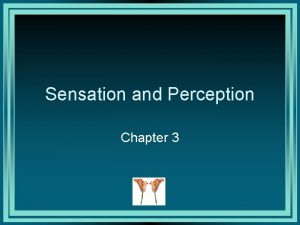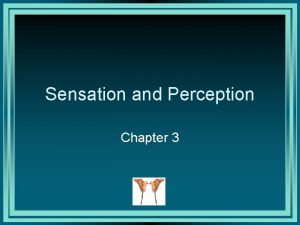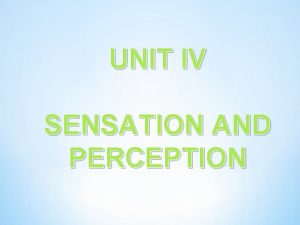Thresholds Sensory Adaption Module 16 Principles of Sensation



















- Slides: 19

Thresholds & Sensory Adaption Module 16

Principles of Sensation • All senses receive stimuli on receptor cells then transform it to action potential then deliver the info to the brain. • Transduction— process where physical energy is converted/transformed into neural signals the brain understands

Psychophysics • This is how we experience our physical world. • When you interact with the world around you, your brain is responding to different environmental stimuli through your senses. Psychophysics studies this. • Classroom demo judging weight of pill bottles. • Which one do you think weighs the most? • The more compact weight “felt” heavier to your brain when in reality it weighed the same as the large container.

Types of Threshold • A Threshold is an edge or a boundary • Psychologists are interested in our boundaries/thresholds when it comes to our senses. • What’s the bare minimum we can sense? • OR What’s the bare minimum required to make our receptor cells fire?

Absolute Threshold • The minimum stimulation necessary for a person to detect a particular stimulus 50% of the time. (see table for examples) • What’s the absolute smallest amount of something in the environment needed for you to be able to detect it for the first time?

Difference Threshold/Just Noticeable Difference • The minimum difference that a person can detect between two stimuli 50% of the time. • What’s the bare minimum needed for a person to detect a change in their sensory information? Absolute Threshold vs. Difference Threshold • If you put your hand on a burner and turned it on, the first time you felt something would be Absolute Threshold and the second you noticed it getting hotter would be Difference Threshold.


Weber’s Law • • Weber’s Law – detection of a stimulus depends on the original stimulus itself. Whether you detect a change depends on the original stimulus and how big the change was LARGE Stimuli require BIGGER Changes for us to notice them Example: If a 300 lb. person loses 20 lbs and a 120 lb. Person loses 20 lbs, which one would you notice lost the weight first? (120 lbs because 20 lbs is a larger % of their body weight) Which one would you notice the $1 price drop more? Which one would you notice a 2 inch haircut on? Review Absolute, JND & Weber’s Law Here!

Thresholds: Signal Detection Theory • Set of formulas and principles that predict when we will detect the presence of a faint stimulus (signal) amid background stimulation (noise) • Developed out of the Cold War & need to detect nukes • Seeks to understand: 1. Why people respond differently to the same stimuli ? 2. Why the same person’s reactions would vary as circumstances change? • Example: Tired parents of newborns will awaken to a whimper but sleep through their alarm.

Signal Detection Theory • • • This theory replaced Weber’s Law Explains why people respond differently to same stimuli Whether or not you detect a stimulus is dependent upon 3 kinds of variables (assumes there is no absolute threshold): 1. Stimulus variables (how weak or strong the stimulus is) 2. Environmental variables (what’s going on around you) 3. Organismic variables (Your own experience, expectations, motivation and alertness) Detect “real” hamburger amongst soy burger Where’s Waldo? Detect poisonous snake amongst harmless ones


Signal Detection Theory This can be used for jobs that depend on one’s ability to accurately detect a threat/stimulus. (Cold War Nuke Detection, Airport Security, Cancer Doctor) Signal Responder Present Absent Hit: False Alarm: Person correctly No signal but Says “Yes” detected signal person said yes Miss: Correct Rejection: Person did not Person correctly Says “No” detect signal noticed there was no signal

Signal Detection Theory Signal Present Responder Hit Signal Absent False Alarm Present Hit Absent False Alarm Says “Yes” 30 Miss 30 Corr. Rej. 20 Miss 20 Corr. Rej. Says “No” 20 20 Liberal: Person more likely to correctly detect A signal but also more likely to falsely detect a signal. 30 30 Conservative: Person less likely to detect a signal but more likely to correctly notice when stimulus is not there.

Do subliminal messages work? • Subliminal messages make two assumptions: 1. We can unconsciously sense the subliminal (below threshold) message. - TRUE 2. Without our awareness, the stimuli have suggestive powers. - FALSE • Subliminal messages can PRIME how we “feel” about something for a short period of time but CANNOT persuade us to actually go out and do something. (pg. 158 in text) • Remember, weak stimuli have weak responses and strong stimuli have strong responses. • Which would be better to remind you of your homework? – – A screen that flashes your assignment in 1/40 of a second? Saying it out loud while having it written on the screen behind me?

I Love Psych!!!

Did it work? • Do you really love psychology now? • It was worth a try! • This is an example of priming someone to feel or think a certain way for a very short period of time.

Sensory Adaptation

Sensory Adaptation Diminished sensitivity to an unchanging stimululs If a stimulus is constant, eventually a person may fail to respond to it – Move your watch up your wrist an inch or put your ring on a different finger. You will feel it at first but later you won’t notice it. Your senses have adapted to it. – This is why the lake water is cold at first but you “get used to it. ” – Also why you don’t feel your glasses on your nose or your clothes on your body. – Remember the displacement goggles experiment from class. This showed motor adaptation to a change in vision. Come on in, the water’s fine

 General adaption syndrom
General adaption syndrom Principles of visual perception
Principles of visual perception 6 principles of sensation
6 principles of sensation 2 cfr 200 procurement
2 cfr 200 procurement Csa basic thresholds
Csa basic thresholds Five thresholds
Five thresholds Csa safety measurement system
Csa safety measurement system Establishing risk thresholds
Establishing risk thresholds C device module module 1
C device module module 1 Sensation seeking
Sensation seeking Branch of sciatic nerve
Branch of sciatic nerve Chapter 5 sensation and perception
Chapter 5 sensation and perception Sensation seeking significato
Sensation seeking significato Chapter 3 sensation and perception
Chapter 3 sensation and perception Ap psych sensation and perception
Ap psych sensation and perception Exteroceptors
Exteroceptors Sensation
Sensation Example of perception
Example of perception Sensation & perception crossword review
Sensation & perception crossword review Chapter 3 sensation and perception
Chapter 3 sensation and perception
